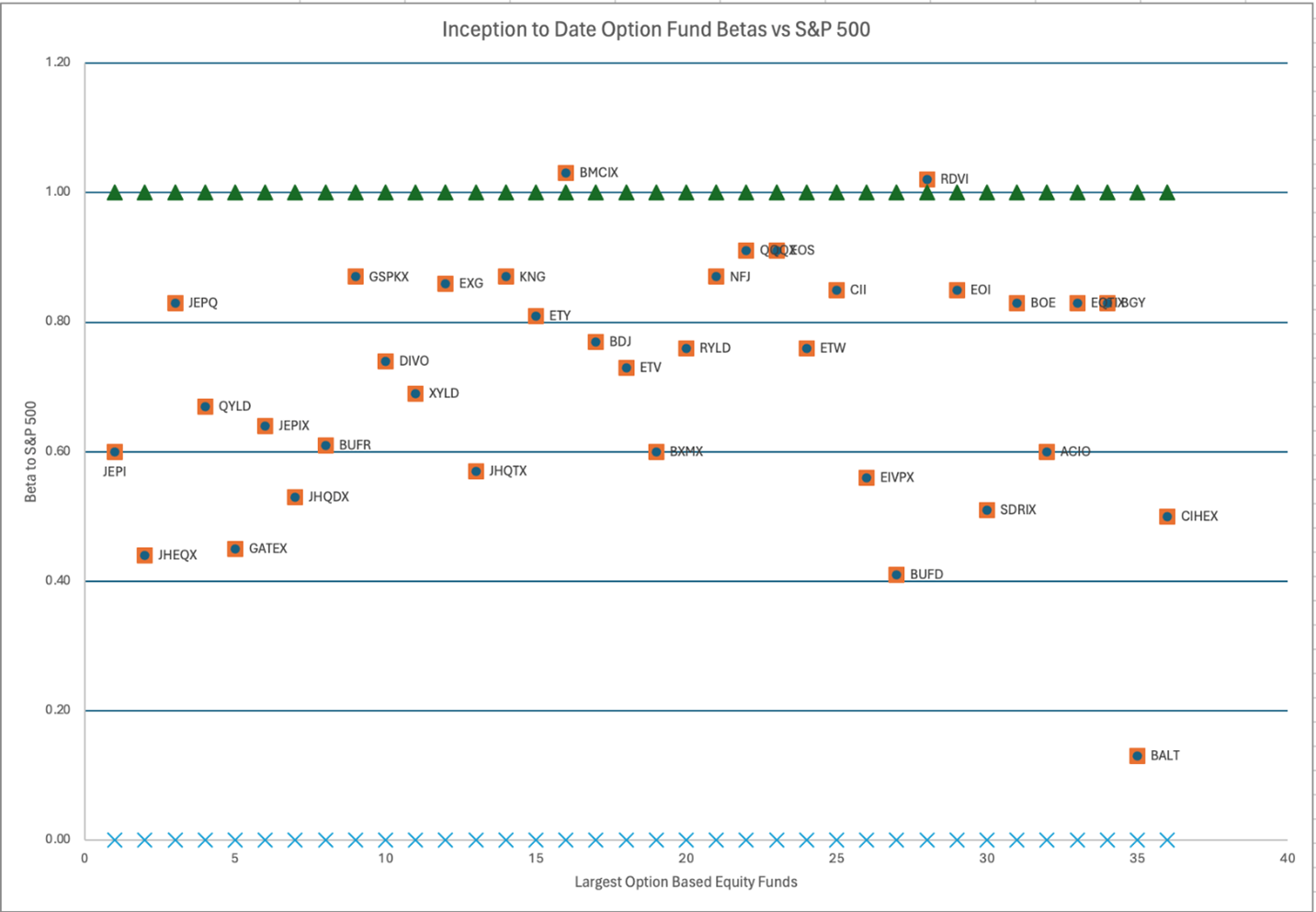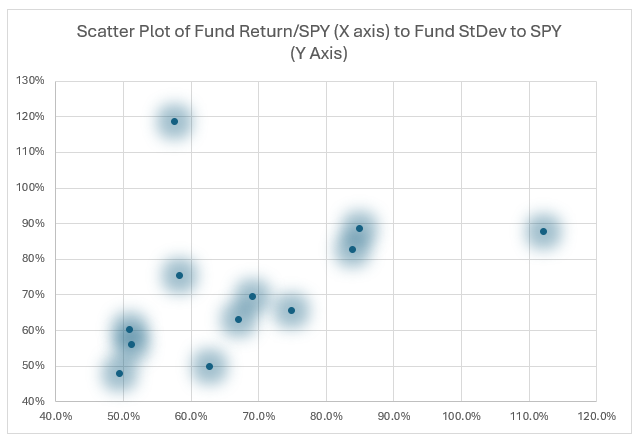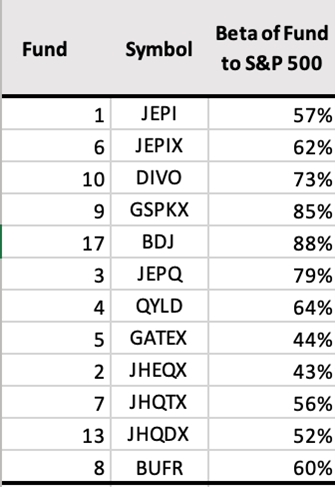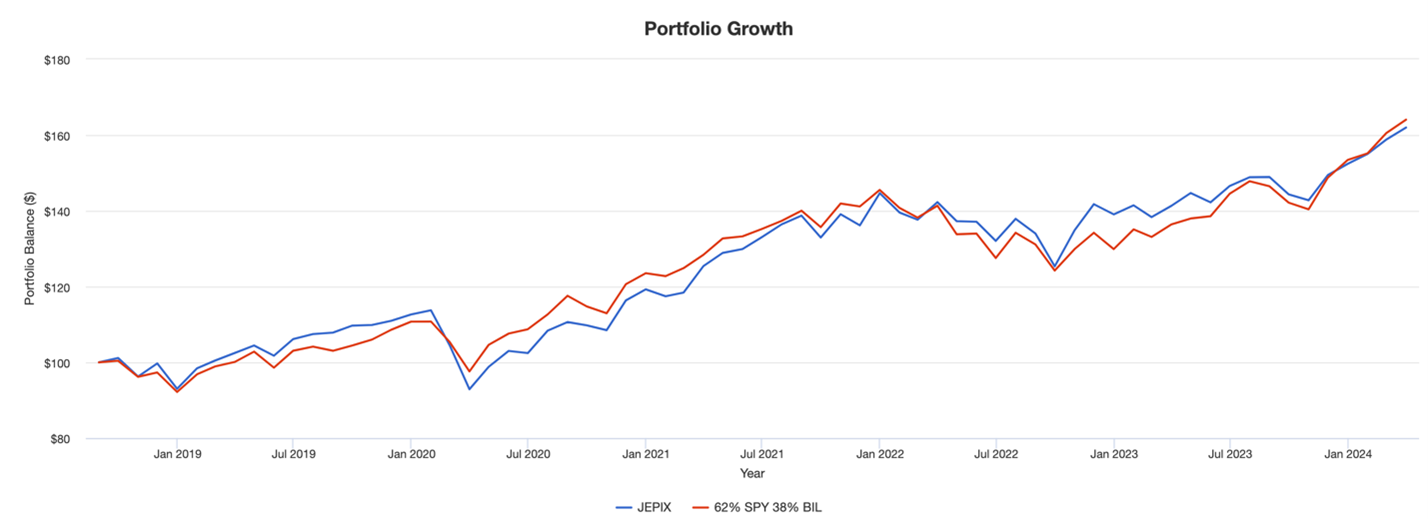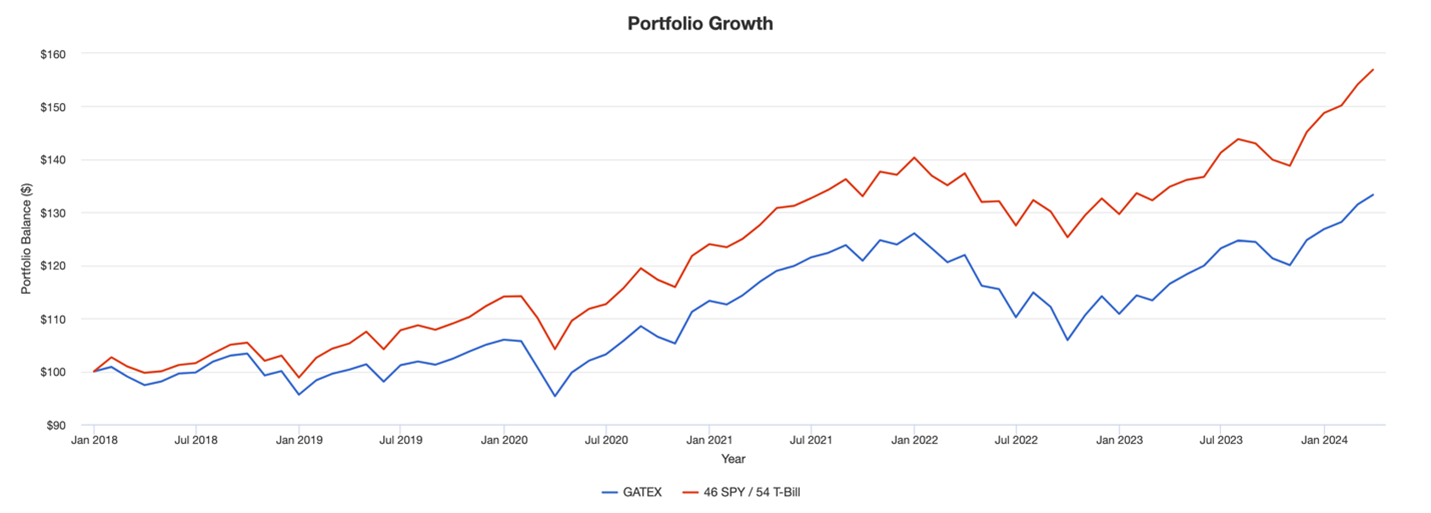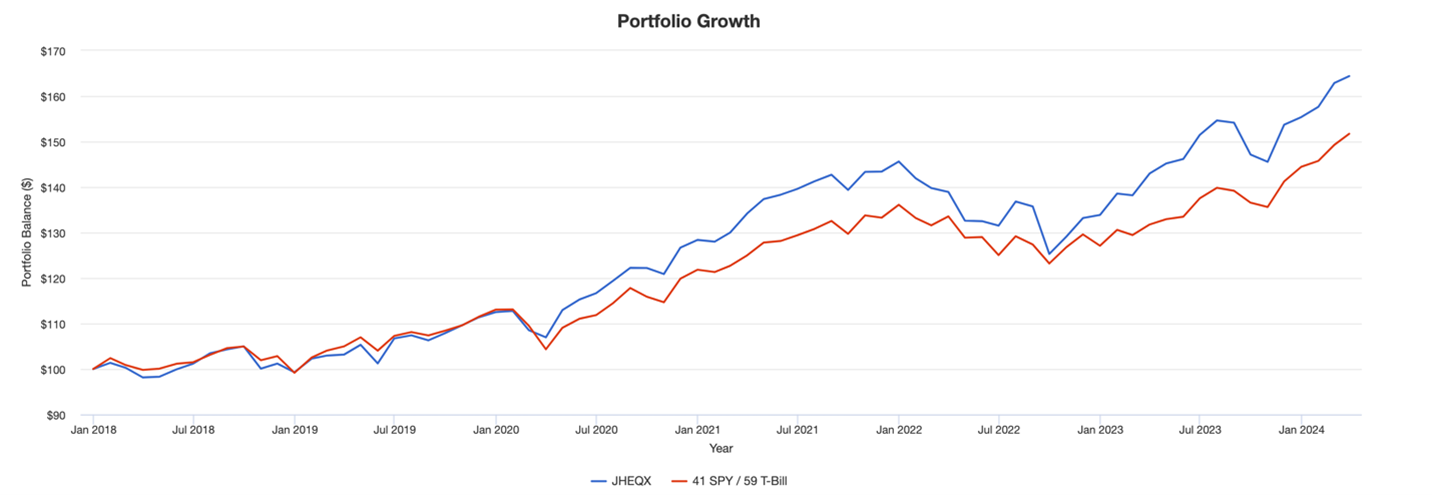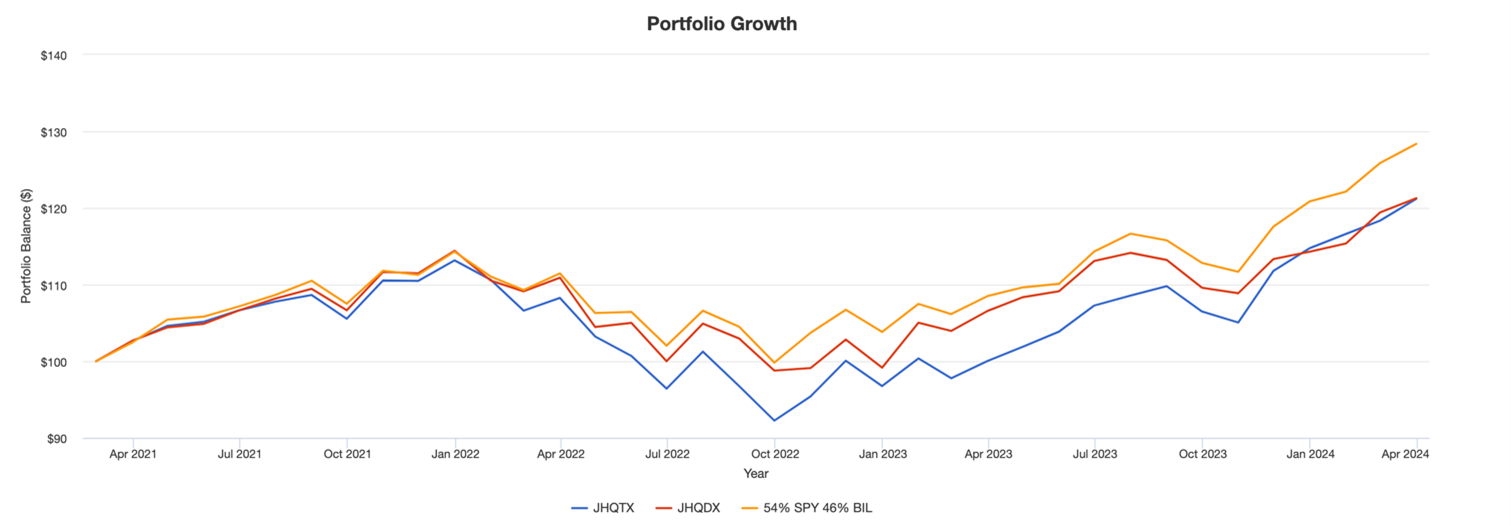Having regarded on the qualitative rationale for why options-based funds are provided by fund managers and sought by some traders, it behooves us to quantitatively analyze choices funds’ efficiency. There isn’t any ONE BENCHMARK that can be utilized to check ALL the choices funds. That could be a very good factor. It’s made me consider what a great way to create a personalized benchmark for every fund would possibly seem like. The advantage of maintaining issues centered on the small image is we are able to take a look at one fund at a time, intimately, with out drawing too many generalizations.
Challenges with possibility fund efficiency comparisons
Nearly all of possibility funds have solely been round for a number of years. This creates challenges in evaluating their efficiency. For instance:
- It’s not doable to run 10, 20, or 30-year analyses on a big sufficient pattern of those funds and we can not consider the funds as an Asset class.
- Range throughout the options-based funds makes it troublesome to check any 2 funds. One of many targets of the accompanying article was to level out the various kinds of Fairness sleeves and the differing selections made by fund managers. We are able to’t evaluate Massive-cap Tech shares to small-call Worldwide worth shares any greater than we are able to evaluate possibility earnings/premium funds to hedged fairness funds. Add the funky new class of funds that carry only one inventory and overwrite each day or weekly choices. There may be NO PEER group right here. Peer Averages imply nothing.
- The final main 50% fairness market crash was in 2007-2009. Most of those funds didn’t exist in that crash or the 2000-2002 50% crash. We don’t understand how these funds will carry out within the subsequent main crash. (PS: There’ll all the time be a subsequent main crash irrespective of how good every little thing appears for the time being).
- The significance of observing lively possibility portfolios by means of a inventory market crash (even bearish portfolios) is to find out how the fund supervisor offers with coincident issues of illiquidity, excessive transaction prices, and volatility to get out and in of shares and choices. Spinoff markets want deep liquidity in underlying shares. In crashes, when this liquidity disappears, spinoff market makers merely stroll away or present absurd costs. How will that have an effect on choices funds? We don’t know but.
- When funds have a younger age, their efficiency data are dictated by the timing of the launch and never essentially the long-term benefit of a method. There isn’t any must get too enthusiastic about each new choices technique. Energetic fairness selecting, excessive charges, and the burden of buying and selling a lot of spinoff contracts all add up as prices. Choices exchanges and choices market makers are raking in tons of income. Who’s paying for it? Don’t go searching. It’s all the cash going into Zero Day choices and choices funds.
Challenges with possibility fund efficiency comparisons: the S&P 500 is an unbeatable index
When I’m launched to any new US Fairness linked fund, my first intuition is to check it to the S&P 500. Is the fund distinctive in any means that may assist my portfolio develop?
Evaluating fairness choices funds to the S&P 500 (or the Nasdaq 100 the place relevant) yields predictably disappointing whole outcomes.
To know why, we should give attention to Fund Betas.
The S&P 500, that’s, the market in US equities, by definition has a Market Beta of 1.
The Betas of most of those choices funds (orange squares within the chart) are decrease than 1 (the S&P 500 marked by the Inexperienced mountain vary).
Since US fairness markets have gone up over time, a decrease beta = decrease market publicity = decrease whole returns.
It’s vital to seize the correct window for calculating returns. I’ve tried to try this beneath.
Utilizing the slender listing of funds we qualitatively described within the accompanying article, I present every fund’s launch date (Column 4) and the analysis window (Column 5). Then, in Column 6, I take a look at the Annualized return of the fund since that date and evaluate it to the Annualized Return of SPY in that window (Column 7).
Evaluating Columns 6 and seven ought to level out that different one fund, JPMorgan Nasdaq Fairness Premium Revenue (JEPQ), no different massive choices fund beat the straightforward passive SPY. What a bummer!
Column 8 compares the Fund’s annualized returns to the SPY’s to point out what % of the SPY the fund earned.
Desk 1
On common, this small collection of funds principally underperformed SPY.
(Fund #3) JEPQ earned 112.1% of SPY whereas (Fund #5) GATEX earned solely 49.4% of the SPY.
Why did JEPQ generate income? As a result of the Fairness sleeve is the Nasdaq 100 sort names. Nasdaq beat the S&P massively for the reason that 2009 bull market began.
Nevertheless, QYLD didn’t succeed. Why? Purpose #1, whereas JEPQ sells out-of-the-money calls on the Nasdaq to earn Revenue, QYLD sells At-the-money calls. In an index going straight up, how we use choices issues. Purpose #2, QYLD has been round since 2013 whereas JEPQ is youthful. It’s one other lesson to attend and decelerate. New funds have a timing good luck/dangerous luck issue.
Take a more true comparability. For JEPQ and QYLD, let’s use QQQ as an alternative of SPY and we get this:
Desk 2
JEPQ now not appears like a star and QYLD appears like a complete dud.
In any case, this evaluation in incomplete. Trying solely on the Whole Return does a disservice to the choices funds. There are different metrics just like the fund’s relative St. Dev to the SPY, Betas, or the Sharpe ratios, the worst drawdowns, and so forth. Let’s take a type of metrics and stretch our evaluation.
Comparability to the S&P 500: Commonplace deviation issues
Buyers’ expectation isn’t that choices funds would earn greater returns. Fairly, traders hope the funds will exhibit decrease volatility and make the trip smoother. The traders hoped to nonetheless earn a few of the fairness returns with decrease volatility than the market.
Desk 3
In actual fact, that’s very a lot the case. Within the above desk, calculated utilizing Portfolio Visualized, I’ve highlighted our small group of funds, this time, in Columns 9 and 10, I’ve introduced how unstable the fund has been in the course of the window on an annualized foundation versus the volatility of the Market. We’ve used % Annualized Commonplace Deviation as a measure. In Column 11, we present the St. Dev of the fund as a % of the SPY.
We are able to see that each one besides (Fund #17) BDJ had a decrease commonplace deviation than the SPY with the triplets of JHEQX/JHQTX/JHQDX (Fund 2, 7, 13) exhibiting the bottom Std. Deviation in comparison with the SPY.
BUFR (Fund 8) isn’t far behind.
These funds are widespread in that these final 5 funds in that desk are “Hedged”, “Protected”, or “Buffered” and intend to supply draw back safety. Those above are usually Revenue suppliers and supply no draw back safety.
In layman’s phrases, it is a vindication of the fund managers’ commercial pitch and the investor’s hopes: Decrease returns accompanied with decrease volatility.
Combining the 2 tables above, I’ve plotted the Return % of those funds and the Std Dev of those funds in comparison with the SPY. In brief, returns between 50-90% with a volatility of 50-90% of the SPY.
Chart 1
Making a replicating portfolio to push our evaluation even additional:
Why ought to we enable choices funds a simple move? In monetary markets, there are a number of solution to get to the identical finish level. We now know that choices funds have a decrease Beta to the S&P 500 (as calculated by means of Portfolio Visualizer)
Desk 4
Let’s take only one fund, JEPIX, which is the Mutual Fund equal to JEPI. Collectively they maintain a mixed $39 Billion in belongings. Utilizing Portfolio Visualizer, I checked the Beta of JEPIX for every calendar 12 months since its inception in Fall of 2018.
Desk 5
JEPIX Betas change dramatically from 12 months to 12 months and appear to be on a downward pattern not too long ago.
Why does the Beta transfer a lot 12 months to 12 months? It may very well be the Fairness Sleeve and which shares go within the portfolio. Maybe the fund managers have a decrease volatility portfolio of shares in 2024 in comparison with 2013. It may be the interplay of the choices used with the Fairness Portfolio and their mixed impact.
It doesn’t matter. These funds are continuously altering their underlying traits as a result of they’re Actively managed. We are able to’t inform what the Fund supervisor is considering. What we CAN DO is inform what the historic Betas have been.
Within the case of JEPIX, the story is that this Fund has a lifetime of 0.62 to the S&P 500 Index.
Proposal: Create a Replicating Portfolio
We all know that the beta of the S&P 500 (which stands for the market index within the USA) is 1 and we all know the Beta of T-Payments is 0. T-Payments have zero beta as a result of these below 1-year Authorities devices don’t have anything to do with the Inventory Market. They’re short-term obligations of the US Authorities issued by the Division of Treasury to fund the Authorities.
We are able to mix a easy 2 fund portfolio of SPY and T-Payments with the ratio of 61% SPY and 39% BIL (the T-Invoice ETF). They received’t have a Beta precisely of 0.62 (in reality, in response to Portfolio Visualizer), the 2-fund Replicating Portfolio has a Beta of 0.59 throughout our Replicating window of Sep 2018 to March 2024. That’s high quality. We’re capturing for simplicity.
Moreover, we are able to select an possibility for Annual Rebalancing in portfolio visualizer so the SPY+BIL portfolio rebalances to 62% SPY each calendar 12 months. (If we don’t try this, SPY will preserve changing into a much bigger % of the portfolio. We need to match the approximate Beta of JEPIX on common over its life).
I ran that straightforward 2-fund portfolio in Portfolio Visualizer alongside JEPIX. Charts and statistics:
Chart 2
Do you see the distinction between the blue line JEPIX and the pink line, Replicating portfolio?
NO? As a result of there isn’t any. The 2 charts look virtually the identical. Possibly just a little extra return in some durations and provides again in others, however the variations are minuscule.
Desk 6
$100 invested in JEPIX and the 2-fund portfolio can be equal nearly the identical 5 ¼ years since launch.
For some traders, it won’t matter that JEPIX isn’t any higher than a easy 62/38 SPY/BIL portfolio. That it’s earned 9% annualized is sweet sufficient. My purpose is to not get traders to purchase or not purchase a fund. It’s to assist simplify and demystify a fund.
Our evaluation brings us as near dwelling as we are able to anticipate to be. If we are able to take all of the magic offered by all of the monetary merchandise and simplify it so we are able to perceive how we are able to reconstruct that magic ourselves, then we would really feel just a little extra assured in our decision-making course of.
Let’s take a case the place the outcomes are NOT equal: GATEX
Step 1: Decide a window to calculate Beta. Let’s go along with 7 years
Desk 7
Step 2: Equal Portfolio = 46% SPY 54% T-Invoice for interval 2018 to 2024 March. Select Annual Rebalancing in Portfolio Visualizer
Step 3: Output 1: Chart3
Output 2: Metrics: Desk 8
GATEX underperforms the Replicating Portfolio by 2.77% per 12 months with the next Commonplace Deviation than the Replication.
By all metrics, GATEX can not beat a passive replicating portfolio. It has a bigger max drawdown and a worse Sharpe Ratio.
Let’s take a case the place the choices fund works effectively: JPMorgan Hedged Fairness Fund (JHEQX).
Step 1: Decide a window to calculate Beta. Let’s go along with 7 years
Desk 9
Step 2: Equal Portfolio = 41% SPY 59% T-Invoice for interval 2018 to 2024 March. Select Annual Rebalancing in Portfolio Visualizer
Step 3: Output 1: Chart 4
Output 2: Metrics
Desk 10
JHEQX had the next annualized return of 1.4% during the last 7 years than its Replicating Portfolio, albeit additionally barely greater commonplace deviation.
JHEQX is an efficient instance of an possibility fund that has thus far labored.
Correct analysis is difficult work
We solely studied a small variety of the over 300 funds devoted to this area, evaluated an excellent smaller quantity, and so we don’t need to make an excessive amount of out of our evaluation.
Analysis requires some work for every fund. It’s not plug-and-play as a result of the Replication portfolio for every fund must first be decided primarily based on the previous Beta of the choices fund.
We’d like a historical past for every fund. We are able to’t do that evaluation for a brand new fund till we’ve seen its beta versus the S&P.
Since I can not do that for 300 choices funds, (and new funds are beginning day-after-day), my purpose was to set a framework that others can construct on.
Let’s speak concerning the fund that appears first rate: JPMorgan Hedged Fairness Fund (JHEQX)
JHEQX is a low-beta fund. On the 0.41 beta, it did a very good job outperforming the equal SPY and T-Invoice portfolio. An fascinating follow-up right here can be the newer JHQTX and JHQDX, designed in the identical vein as JHEQX. As Chart 5 beneath reveals, the Replicating Portfolio’s Orange line beat them each. Possibly the funds want extra time? Each time we expect choices funds would possibly outperform, we peel the onion, and the proof requires extra time or extra evaluation.
Chart 5
The Fairness Sleeve
Earlier than we conclude, I need to level out that selecting the right Fairness Sleeve is essential. An extended Nasdaq fairness sleeve was so highly effective during the last 10-years that it washed away any crimes dedicated on the choices legs.
Alternatively, selecting EM or Developed Market Passive Fairness sleeve may have been a horrible alternative. No quantity of choices cleverness would have dissolved the crime of being invested in a passive EM ETF.
Coming to an finish: There’s a purpose why individuals purchase/maintain these funds
We took a disparate group of options-based funds and united them. We confirmed that Whole Returns and commonplace deviation needed to be checked out in sync and we achieved this by means of the fund’s historic betas, created replicating portfolios, and used the fund’s return collection to check to the replicating portfolios. Our outcomes are vital as a result of they’re grounded in simplicity, and anybody can replicate the outcomes. Anybody can decide if “their” fund holds water.
Whereas analyzing quantitatively is vital, we must always keep in mind individuals purchase these funds for no less than a number of totally different causes:
- Their brokers/advisors promote them the funds
- Buyers will not be focused on creating low-beta portfolios and rebalancing
- Incomes earnings was once vital in a zero-rate world. Choices funds had a spot. With T-Payments at 5.25%, perhaps the choices for Revenue funds should be rethought. However as soon as invested, the inertia to take cash out is nice. Funding merchandise are sticky.
- Tax payments are all the time a hindrance.
If we go to David Snowball’s thesis, “30% Fairness Allocation will get you a majority of the inventory market’s returns however skip many of the volatility”, we are able to admire the great thing about low-beta portfolios (the success of JHEQX). Some choices Funds promise and ship the low beta portfolios. Some funds do it higher than others (= GATEX) and it’s our job as finish traders to select the great ones and ignore the poor ones.
Whereas options-based funds maintain no magic bullets, and a majority of their returns may be replicated by easy SPY+T-Invoice portfolios, there’ll all the time be a requirement for choices funds. For so long as traders have been invested in dangerous belongings, they’ve needed a smoother trip.



